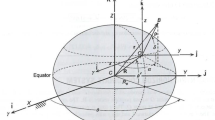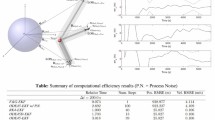Abstract
With easier access to space and mega-constellation plans, tracking the resident space object (RSO) population becomes a greater challenge. Efficiently obtaining the maximum possible knowledge from each RSO observation is required for improved propagation and identification. Observability and estimability have been used to mathematically define which parameters of a dynamical system can be determined with certain measurement types and to interpret how well the states are or can be estimated relative to one another. This work analyzes both observability, in a deterministic and in a stochastic sense, and estimability as measures to judge either a priori or a posteriori estimation results. The system of interest in this work is an RSO orbit with object characteristic information.





















Similar content being viewed by others
References
Ablin H.L.: Criteria for degree of observability in a control system (1967)
Aoki, M.: On observability of stochastic discrete-time dynamic systems. J. Frankl. Inst. 286(1), 36–58 (1968)
Bageshwar, V.L., Gebre-Egziabher, D., Garrard, W.L., Georgiou, T.T.: Stochastic observability test for discrete-time Kalman filters. J. Guid. Control Dynam. 32(4), 1356–1370 (2009)
Baram, Y., Kailath, T.: Estimability and regulability of linear systems. IEEE T. Automat. Contr. 33(12), 1116–1121 (1988)
Bay, J.S.: Fundamentals of linear state space systems. 1st edn. McGraw-Hill Science/Engineering/Math (1998)
Beutler, G.: Methods of celestial mechanics. Vol. II : Application to Planetary System Geodynamics and Satellite Geodesy, vol. 2. Springer, Heidelberg (2005)
Brown, R.G.: Not just observable, but how observable/ques/(Observability and controllability in providing heuristic understanding of control problems, noting Kalman filter theory). In: 22nd National Electronics Conference, pp 709–714. IL, Chicago (1966)
Chen, Z.: Local observability and its application to multiple measurement estimation. IEEE T. Ind. Electron. 38(6), 491–496 (1991)
Dianetti, A.D., Weisman, R.M., Crassidis, J.L.: Application of observability analysis to space object tracking. In: AIAA Guidance, Navigation, and Control Conference, AIAA SciTech Forum American Institute of Aeronautics and Astronautics (2017), https://doi.org/10.2514/6.2017-1258
Eapen R.T., Frueh C.: Averaged solar radiation pressure modeling for high area-to-mass ratio objects in geosynchronous orbits. Adv. Space Res. 62(1), 127–141 (2018). https://doi.org/10.1016/j.asr.2018.03.042https://doi.org/10.1016/j.asr.2018.03.042
Früh, C., Jah, M.K.: Coupled orbit–attitude motion of high area-to-mass ratio (hamr) objects including efficient self-shadowing. Acta Astronaut. 95, 227–241 (2014). https://doi.org/10.1016/j.actaastro.2013.11.017https://doi.org/10.1016/j.actaastro.2013.11.017
Friedman, A.M.: Observability analysis for space situational awareness. PhD Thesis, Purdue University (2020)
Friedman, A.M., Frueh, C.: Determining characteristics of artificial near-Earth objects using observability analysis. Acta Astronaut. 144, 405–421 (2018)
Friedman, A.M., Frueh, C.: Observability of Light Curve Inversion for Shape and Feature Determination Exemplified by a Case Analysis. J. Astronaut. Sci. submitted (2020)
Früh, C., Schildknecht, T.: Variation of the area-to-mass ratio of high area-to-mass ratio space debris objects. Mon. Not. R. Astron. Soc. 419 (4), 3521–3528 (2012)
Gajic, Z., Lelic, M.: Modern control systems engineering. Prentice-Hall, Inc, Hoboken (1997)
Ge, Q., Ma, J., Chen, S., Wang, Y., Bai, L.: Observable degree analysis to match estimation performance for wireless tracking networks. Asian. J. Control 19(4), 1259–1270 (2016). https://doi.org/10.1002/asjc.1386
Geeraert, J., McMahon, J.W., Jones, B.A.: Orbit Determination Observability of the Dual-Satellite Geolocation System with TDOA and FDOA. In: AIAA/AAS Astrodynamics Specialist Conference, p 5367 (2016)
Goshen-Meskin, D., Bar-Itzhack, I.Y.: On the connection between estimability and observability. IEEE T. Automat. Contr. 37(8), 1225–1226 (1992). https://doi.org/10.1109/9.151112
Ham, F.M.: Determination of the degree of observability in linear control systems (1980)
Ham, F.M., Brown, R.G.: Observability, eigenvalues, and kalman filtering. IEEE T. Aero. Elec. Sys. AES-19(2), 269–273 (1983). https://doi.org/10.1109/TAES.1983.309446
Hermann, R., Krener, A.: Nonlinear controllability and observability. IEEE T. Automat. Contr. 22(5), 728–740 (1977). https://doi.org/10.1109/TAC.1977.1101601
Hong, S., Chun, H.H., Kwon, S.H., Lee, M.H.: Observability Measures and Their Application to GPS/INS. IEEE T. Veh. Technol. 57(1), 97–106 (2008). https://doi.org/10.1109/TVT.2007.905610
Huxel, P.J.: Navigation algorithms and observability analysis for formation flying missions (2006)
Jazwinski, A.H.: Stochastic processes and filtering theory. Academic Press, Cambridge (1970)
Kalman, R.: On the general theory of control systems. IRE T. Autom. Control. 4(3), 110–110 (1959). https://doi.org/10.1109/TAC.1959.1104873
Lang, D., Hogg, D.W., Mierle, K., Blanton, M., Roweis, S.: Astrometry.net: Blind astrometric calibration of arbitrary astronomical images. Astron. J. 137, 1782–2800 (2010)
Lee, M.H., Park, W.C., Lee, K.S., Hong, S., Park, H.G., Chun, H.H., Harashima, F.: Observability analysis techniques on inertial navigation systems. J. Sys. Des. Dyn. 6, 28–44 (2012). https://doi.org/10.1299/jsdd.6.28
List, B.: Decomposition of a covariance matrix into uncorrelated and correlated errors. In: Alliance Workshop on Unfolding and Data Correction (2010)
Longman, R., Sirlin, S.: The fundamental structure of degree of controllability and degree of observability. In: Astrodynamics Conference, p 1434 (1982)
Montenbruck, O., Gill, E.: Satellite Orbits: Models, Methods, and Applications. Springer Science & Business Media, Heidelberg (2000)
Morales, J.J.: Stochastic observability and uncertainty characterization in simultaneous receiver and transmitter localization. IEEE Transactions on Aerospace and Electronic Systems 9 (2017)
Ogata, K.: State Space Analysis of Control Systems. Prentice-Hall, Hoboken (1967)
Pelton, J.N.: Tracking of Orbital Debris and Avoidance of Satellite Collisions. In: Pelton, J.N., Madry, S., Camacho-Lara, S (eds.) Handbook of Satellite Applications, pp 1–13. Springer, New York (2016)
Press, W.H., Teukolsky, S.A., Vetterling, W.T., Flannery, B.P.: Numerical recipes 3rd edition: The art of scientific computing, 3rd edn. Cambridge University Press, Cambridge (2007)
Rodriguez, H., Abercromby, K., Mulrooney, M., Barker, E.: Optical properties of multi-layered insulation. In: Advanced Maui Optical and Space Surveillance Technologies Conference (2007)
Rothman, Y., Klein, I., Filin, S.: Analytical observability analysis of INS with vehicle constraints. Navigation 61(3), 227–236 (2014). https://doi.org/10.1002/navi.63
Sanson, F., Frueh, C.: Quantifying uncertainties in signal position in non-resolved object images: Application to space object observation (2019)
Schmidt, S.F.: Application of state-space methods to navigation problems. In: Advances in control systems. 3rd edn., pp 293–340. Elsevier (1966)
Shao, Y.: Observability and performance analysis of integrated GPS/INS navigation systems (2006)
Silva, F.O., Hemerly, E.M., Leite Filho, W.C.: On the Error State Selection for Stationary SINS Alignment and Calibration Kalman Filters–Part II: Observability/Estimability Analysis. Sensors (Basel, Switzerland). 17(3) https://doi.org/10.3390/s17030439, 28241494 (2017)
Straub, J.: Cubesats: A low-cost, very high-return space technology (2012)
Tapley, B.D., Schutz, B.E., Born G.H.: Statistical Orbit Determination. Academic Press, Cambridge (2004)
Vallado, D.A.: Fundamentals of astrodynamics and applications. Springer Science & Business Media, Heidelberg (2001)
Woodbury, D., Junkins, J.: On the consider kalman filter. In: AIAA Guidance Navigation, and Control Conference (2010)
Acknowledgments
This work was funded through the Department of Defense Science, Mathematics And Research for Transformation (SMART) Scholarship-for-Service Program. The views expressed in this article are those of the authors and do not necessarily reflect the official policy or position of the Air Force, the Department of Defense, or the U.S. Government.
Author information
Authors and Affiliations
Corresponding author
Ethics declarations
Conflict of Interests
On behalf of all authors, the corresponding author states that there is no conflict of interest.
Additional information
Publisher’s Note
Springer Nature remains neutral with regard to jurisdictional claims in published maps and institutional affiliations.
Rights and permissions
About this article
Cite this article
Friedman, A.M., Frueh, C. Observability and Estimability Analysis of Geosynchronous Objects with Angles-Only Measurements. J Astronaut Sci 68, 503–534 (2021). https://doi.org/10.1007/s40295-021-00261-4
Accepted:
Published:
Issue Date:
DOI: https://doi.org/10.1007/s40295-021-00261-4




